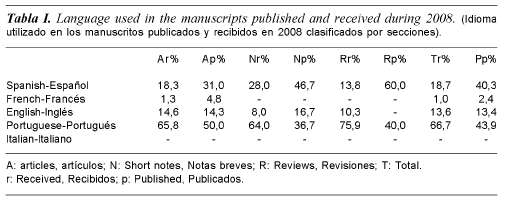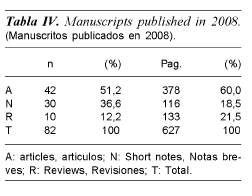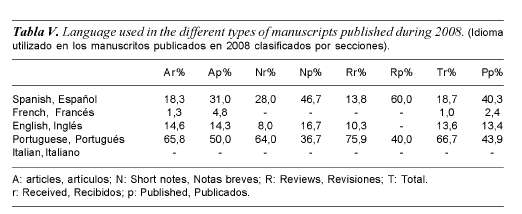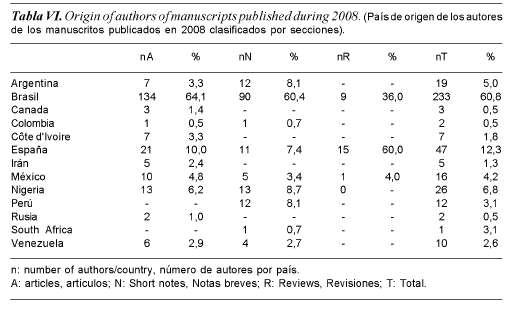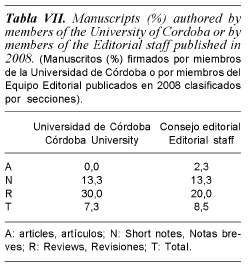Meu SciELO
Serviços Personalizados
Journal
Artigo
Indicadores
-
 Citado por SciELO
Citado por SciELO -
 Acessos
Acessos
Links relacionados
-
 Citado por Google
Citado por Google -
 Similares em
SciELO
Similares em
SciELO -
 Similares em Google
Similares em Google
Compartilhar
Archivos de Zootecnia
versão On-line ISSN 1885-4494versão impressa ISSN 0004-0592
Arch. zootec. vol.58 no.221 Córdoba Mar. 2009
Archivos de Zootecnia. Editorial report 2008
Archivos De Zootecnia. Informe editorial 2008
Gómez Castro, A.G.1*, M.C. López de Bustamante1, J. Perea Muñoz1 y J. Arcos Castejón1
1Oficina Editorial de Archivos de Zootecnia. Departamento de Producción Animal. Universidad de Córdoba Campus de Rabanales. 14014 Córdoba. España. *pa1gocag@uco.es
SUMMARY
The editorial process of Archivos de Zootecnia during 2008 is reported below. A total of 294 manuscripts were received from 24 countries mainly from Brazil (73%). Consequently, the language most frequently used in the manuscripts was Portuguese, followed by Spanish and English. The mean time between reception and publication of a manuscript was high (657 days). The rejection rate was 35.7%. In 2008, 42 articles, 30 short notes and 10 reviews (total 82) were published from 13 countries.
Key words: Scientific journals. Scientific papers.
RESUMEN
Se revisa el proceso editorial de Archivos de Zootecnia durante 2008. Se recibieron 294 manuscritos procedentes de 24 países, principalmente de Brasil (73%). Consecuentemente, el primer idioma más utilizado fue el portugués seguido del español y el inglés. El tiempo medio entre recepción y publicación es elevado (657 días). La tasa de rechazo fue del 35,7%, publicándose 42 artículos, 30 notas breves y 10 revisiones bibliográficas, en total 82 contribuciones procedentes de 13 países.
Palabras clave: Revistas científicas. Artículos científicos.
Introduction. Methodological considerations
In 2007, the first editorial report of Archivos de Zootecnia was published (http://www.uco.es/organiza/servicios/publica/az/php/img/web/16_10_18_Informeeditorial2007.pdf).
In order to increase the precision and accuracy of the data for 2008, the calculation of some parameters has been changed from the previous editorial report, as follows:
The rate of acceptance, or rejection, was calculated as the number of accepted or rejected manuscripts during the year 2008 (without taking into account the year of receipt) divided by the total number of manuscripts received during 2008, in each section. This accounts for the fact that the time needed for rejection is significantly shorter than the time needed for acceptance.
The origin of the manuscripts has been obtained by taking into account the nationality of all authors, while in 2007 only the predominant authors' nationality was considered.
Finally, to establish the topics treated in the manuscripts, up to six subjects were considered simultaneously for each manuscript, while in 2007, the manuscripts were classified only by their main area.
Received manuscripts
During the year 2008, 294 manuscripts were received by Archivos de Zootecnia, 240 of which were presented as articles, 25 as short notes, and 29 as literature reviews.
Most of the received papers (73%) came from Brazil, a figure similar to the previous year, which can be justified in part by the positive valuation that Archivos de Zootecnia received in Qualis. Studies originating from Mexico, Nigeria, and Spain, represented an additional 18% (around 6% each), and the remaining 9%, came from other 19 countries, in proportions very similar and generally within the scope of projection of the magazine.
As shown in table I, the origin of the papers is reflected on the language used. However the Portuguese represents 66.7%, which is lower than the percentage of items of Portuguese origin; Spanish was used in 18.7% of the manuscripts (which is lower as compared to the previous year). The use of English (13.6%) increased slightly. Only very few papers (1%) were writen in French. As in previous years, not articles were received in Italian.
The topics covered in papers published in Archivos de Zootecnia (table II) are distributed as follows. The animal species studied are mainly, cattle (12.1%), sheep (8.3%) and goats (6.8%). Pigs, chickens and horses also received some attention. A increasing number of manuscripts (7,3%) used other, less conventional, species. The studies often focused on nutrition and food (11.1%), coarse foods (5.2%) and concentrates (2.3%), although this area is proportionately lower than in 2007. In regard to the various animal products, the most attention was focused on growth, carcass, and meat (11.8%) focused the most attention, and also milk, eggs and honey (4.5% in total). Genetics, conservation and improvement of breeds, were covered in nearly 7% of the received manuscripts. A significant 4.5% of the manuscripts dealed with reproduction; animal behavior, handling, welfare, and the environment in livestock production, represented a 4.6% of the papers. Finally, health (3.6%) and rural development (2.8%) complete the table of topics covered in the journal during 2008.
Reviews
Each paper submitted to Archivos de Zootecnia is first reviewed by members of the Editorial Board and Advisory Council. Subsequently, the Editorial Board, at its plenary session, analyzes each manuscript submitted and decide if it must be reviewed (in which case at least two and up to four reviewers are assigned) or rejected. Reviewers are chosen from a repertoire of 600 international experts from many countries.
As shown in table III, the average review time of 133.6 days of evaluation improved as compared to 260.9 days in 2007. However, the time from acceptance to publication has risen from 306.0 in 2007 to 414.2 days. Consequently, the time between submission of a manuscript and its publication has risen to 657.3 days, which means a delay of almost 100 days over 2007. These waiting times are too high and, although the causes are found in all stages, it is often the authors themselves that caused most delays during the correction of their manuscripts.
A more detailed analysis of these data shows that the management of the reviews and feedback from reviewers has substantially improved the management of evaluations and feedback from reviewers, however, there is still a lot to be improved. The accumulation of delays during the publication phase is derived from the large number of manuscripts received and approved, which far exceeds the number of articles included in the paper edition due to strictly budgetary reasons. The potential to shorten the waiting time to publication is scarce, especially in the current economic climate. A solution, which Archivos de Zootecnia is curently implementing, is the loading of a early on line publicación. At the moment this advance on line publication, is released three months before the paper edition.
The acceptance and rejection rate on the papers received in 2008 reached 40.8% and 35.7% respectively. The sum of these rates (76.2%) does not imply that only 23.8% of the manuscripts received during 2008 are pending on a decision, since in fact there are many more papers in revision. As the decision delay is shorter, more approved or rejected manuscripts, accumulate in 2008.
Published papers
The journal Archivos de Zootecnia published 82 papers during 2008 (table IV), 10 more than those published in 2007, as a result of an increase in articles and reviews.
Table V, shows that the distribution of languages partially account for the imbalance in favor of Portuguese in the manuscripts, so that just over 40% of the work is published in Portuguese, and a similar amount, in Spanish, confirming and emphasizing what has been observed in 2007, while other languages adjusts to the proportion recorded in the manuscripts.
About 61% of the authors are Brazilians. The second largest group is formed by Spanish authors (12.3%), and finally Nigeria, Argentina and Mexico, in comparable proportions, accumulate 16% of the authors. The remaining authors are from other 8 countries (table VI).
Interestingly, as shown in table VII the percentage of manuscripts in which at least one author belongs to the University of Cordoba (the publisher) or is any of the 24 members of the Editorial board, or Advisory, Council does not exceed 7.3% or 8.5%, respectively.
The topics of the published papers were distributed in the same manner described for manuscripts in table II with only minor differences, except for goats production rising from 6.8% to 12.2%.
Difussion. Online and paper editions
Archivos de Zootecnia is included in about 400 directories or electronic databases (Agricultural BIOSIS, CAB abstracts, Latindex, Scopus ...), making the journal easily located. If the word "zootecnia" is used as search criterion in the search engine Google: Archivos de Zootecnia appears as the second entry of 3.100,000 results. If the query is "Archivos de Zootecnia" there are 25,800 results, and if the search is done by "Arch. Zootec." There are 7,580 results find, most of which are citations of papers published in the journal. During 2008, Archivos de Zootecnia in its online edition received 342,385 visits (compared with 271,969 in 2007), reaching one million (since 2005). This represented a total of 463,678 page views in 2008 with an average of almost a thousand visits (almost 1400 pages views) per day.
The volume 57, in its electronic version contains 10 reviews (133 pages) that have been downloaded 3,260 times (326 average, maximum of 955 and a minimum of 16 for the latest manuscripts posted on the website). It is expected to increase this figure more than proportionally in successive years.
Most visits (75%) to the web page of Archivos de Zootecnia are of unknown origin (.com .net, .org, etc. domains).
Among the countries that can be identified, Russia is the country which contributes the highest number of visitors (over 35,000) followed by Brazil 9100, Mexico 6567 and Spain 6347, and followed about 100 other countries. The 82 papers, reviews and short notes published in 2008 received an average of 3800 visits per contribution.
The printed version (500 copies printed) of the journal is distributed over 60 countries, either as subscriptions or through exchanges for other journals.











 texto em
texto em 

